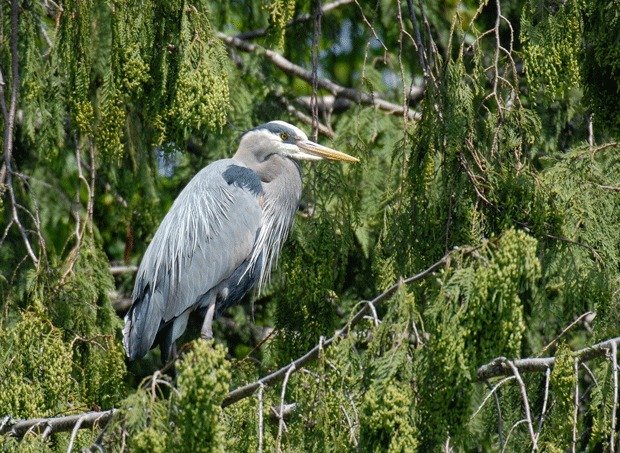I’m getting reports of Nature Channel quality sightings of great blue herons at Greenbank farm.
The farm’s executive director, Judy Feldman, recently emailed me, “Wow, the heron rookery just came alive! About 30 birds rose up like a plume of prehistoric smoke.” Later she reported seeing 50 of the herons.
A heron colony thrives to the west of Highway 525 and the birds fly over the farm to stalk the beaches of Saratoga Passage for food. May and June are the most active months when eggs are hatching and young are being fed.
Judy continued, “Seeing them in their nests, flying together as a group, or stalking the fields and wetlands alone, I always feel more connected to this place called Greenbank Farm, its past as well as its future. It’s like they stitch together all of the people, communities, activities, and traditions that have shown up here over the millennia.”
Heron breeding colonies are probably not what you’d expect from this tall, gangly, long-legged and long-necked, beach-loving bird. They choose a grove of trees and then create loose stick nests near the tops. Sometimes several pairs will nest in one fairly insubstantial tree. And some colonies of herons contain up to 100 birds.
If you’ve ever watched a heron stalking fish for its prey, you’ll understand why some indigenous cultures claim that herons contain the souls of wise men. The herons wade or stand perfectly still in shallow water waiting for small fish to venture close. When unwary fish do come near, they strike with their sharp stiletto bills.
During flight, the birds fold their long necks back into an S-shape and stretch their legs out behind them. Their broad wings carry them through the air with deep, slow wing beats.
For many years the heron population on Whidbey was in a sharp decline. Their open nests provided little protection from bald eagles that fed on the young. As our eagle population grew, the heron population decreased.
Then the osprey came to the rescue. That species feeds exclusively on fish and doesn’t bother the heron colonies. The more recent increase in osprey nests has benefitted the great blue herons.
Somehow the herons have figured out that if they establish their colony near an osprey nest, those raptors will ward off the eagles, leaving the heron chicks alone.
I’ve never seen a young great blue heron up close, but I once helped raise a young wood stork, a fairly close relative to the heron. My husband and I were setting up a birding survey in a small Mexican village on the Caribbean Sea. Wood storks nested on an offshore island and, like the herons, built flimsy nests.
One day a fisherman brought in a baby wood stork that had fallen out of its nest. He pretty much dumped the downy-plumed wood stork in our laps and asked if we would care for it. Neither of us had any experience raising wildlife, so the fisherman agreed to bring us live feeder fish each day.
Soon “Woodie” was part of the family. We kept him in a pen enclosure and every evening we filled an aluminum tub with live fish. Woodie caught and gulped down the fish with no training and great facility. My husband and I marveled at the speed in which he could polish off about 20 fish in 20 seconds.
Back here on Whidbey, our great blue herons will begin fledging in the next few weeks. And by summer’s end the colony will be empty.
Although sociable in their nesting habits, after breeding season the birds turn into loners and stake out individual winter feeding territories. They seem to hunker down in winter and turn back into those images of wise old souls.
Frances Wood can be reached at wood@whidbey.com Craig Johnson is at Craigjohnson@whidbey.com


